The beauty of a thriving planted aquarium is undeniable; it is like an exotic slice of nature in your living room. Many people shy away from advancing to a live planted aquarium because they think it is too difficult. Some folks have tried, and failed, and decided that live plants are not for them. Whatever the cause for not keeping live plants may be, the truth is that keeping live plants can be easy with a little guidance to help your chances of success. There are a wide variety of easy to keep aquarium plants available, here are my top ten. I have separated these into two groups, with smaller plants listed as foreground plants, which are also well suited for shorter aquariums. The second group is for mid-ground and background plants, which will work well, planted behind foreground plants, and can be incorporated into taller aquariums.
Foreground Aquarium Plants
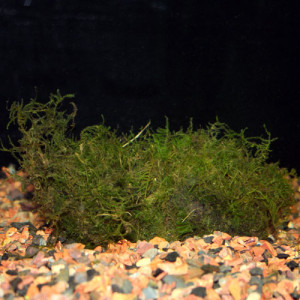 Java Moss (Vesicularia dubyana) is fairly undemanding. It can be left floating or attached to a surface like wood or rockwork (anchor in place with fishing line or another tie and remove the ties when plant has attached). It will form mats that provide hiding places for inverts and fish fry as well as a low foreground texture to the aquarium. Java Moss will thrive in low light aquariums, and requires no special care.
Java Moss (Vesicularia dubyana) is fairly undemanding. It can be left floating or attached to a surface like wood or rockwork (anchor in place with fishing line or another tie and remove the ties when plant has attached). It will form mats that provide hiding places for inverts and fish fry as well as a low foreground texture to the aquarium. Java Moss will thrive in low light aquariums, and requires no special care.
 Moss Balls (Chladophora aegogrophila) Moss Balls are a truly unique addition to planted aquariums. They are non-invasive structures that are actually made from algae shaped by wave action. Moss Balls are low maintenance, tolerating a wide range of water conditions and tolerant of minimal lighting (though they thrive better in moderate lighting). They may be left in their ball shape or split and attached to a surface like driftwood or rockwork (use fishing line or another anchor until attached, then remove the ties).
Moss Balls (Chladophora aegogrophila) Moss Balls are a truly unique addition to planted aquariums. They are non-invasive structures that are actually made from algae shaped by wave action. Moss Balls are low maintenance, tolerating a wide range of water conditions and tolerant of minimal lighting (though they thrive better in moderate lighting). They may be left in their ball shape or split and attached to a surface like driftwood or rockwork (use fishing line or another anchor until attached, then remove the ties).
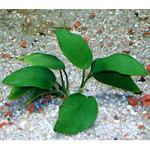 Anubias Nana (Anubias barteri ‘nana’) There are several forms of Anubias Barteri, that have been developed for aquarium use, with Anubias Nana being the most common. Anubias plants are characterized by their broad, thick, dark green leaves. Anubias Nana is an extremely tough plant, which can be kept with fish that may eat other more delicate species. This plant will thrive in low to medium light aquariums, and a wide range of water conditions.
Anubias Nana (Anubias barteri ‘nana’) There are several forms of Anubias Barteri, that have been developed for aquarium use, with Anubias Nana being the most common. Anubias plants are characterized by their broad, thick, dark green leaves. Anubias Nana is an extremely tough plant, which can be kept with fish that may eat other more delicate species. This plant will thrive in low to medium light aquariums, and a wide range of water conditions.
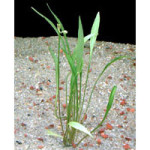 Narrowleaf Chain Sword (Echinodorus tenellus) Also known as Pygmy Chain Sword, this grasslike plant is one of the smallest of the sword family, and is an excellent choice as a foreground plant, or for small aquariums. Narrowleaf Chain Sword is tolerant of a wide range of water conditions, but requires moderate to high lighting to maintain its small size.
Narrowleaf Chain Sword (Echinodorus tenellus) Also known as Pygmy Chain Sword, this grasslike plant is one of the smallest of the sword family, and is an excellent choice as a foreground plant, or for small aquariums. Narrowleaf Chain Sword is tolerant of a wide range of water conditions, but requires moderate to high lighting to maintain its small size.
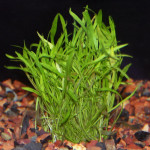 Micro Sword – (Lilaeopsis brasiliensis) Micro Sword is another excellent foreground plant, and is a staple for aquatic gardeners of all levels. This plant forms dense green mats, which resemble a green carpet across the bottom of the aquarium. Tolerant of a wide range of water conditions, this plant is a fast grower, but requires strong lighting to keep a short dense appearance.
Micro Sword – (Lilaeopsis brasiliensis) Micro Sword is another excellent foreground plant, and is a staple for aquatic gardeners of all levels. This plant forms dense green mats, which resemble a green carpet across the bottom of the aquarium. Tolerant of a wide range of water conditions, this plant is a fast grower, but requires strong lighting to keep a short dense appearance.
Mid-ground and Background Aquarium Plants
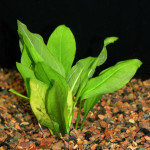 Amazon Sword (Echinodorus bleheri) The Amazon Sword is one of the most iconic aquarium plants used in the hobby, and is probably what most people visualize when they think about aquarium plants. These plants are tolerant of a wide range of water conditions, and can grow quite large. These plants can also survive in low to medium light, but will thrive in medium to high light levels. Be careful not to plant smaller species close to this plant, as it will overshadow smaller plants in a short amount of time.
Amazon Sword (Echinodorus bleheri) The Amazon Sword is one of the most iconic aquarium plants used in the hobby, and is probably what most people visualize when they think about aquarium plants. These plants are tolerant of a wide range of water conditions, and can grow quite large. These plants can also survive in low to medium light, but will thrive in medium to high light levels. Be careful not to plant smaller species close to this plant, as it will overshadow smaller plants in a short amount of time.
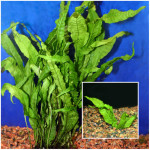 Java Fern (Microsorum pteropus) Java Fern is a hardy plant that tolerates a wide range of conditions. They can tolerate lower lighting as well as the higher pH and hard water of cichlid aquariums and aquariums with higher lighting. They even may be used in brackish water aquariums with low salinity. Java Fern can easily be attached to driftwood and rockwork, and can form a dense covering on these structures if allowed. Mature plants can grow leaves up to a foot in length.
Java Fern (Microsorum pteropus) Java Fern is a hardy plant that tolerates a wide range of conditions. They can tolerate lower lighting as well as the higher pH and hard water of cichlid aquariums and aquariums with higher lighting. They even may be used in brackish water aquariums with low salinity. Java Fern can easily be attached to driftwood and rockwork, and can form a dense covering on these structures if allowed. Mature plants can grow leaves up to a foot in length.
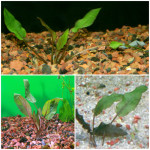 Cryptocoryne (Cryptocoryne wendtii) Cryptocoryne wendtii is one of the most popular of the Cryptocoryne plants, which are commonly called Crypts. They are adaptable to most aquarium conditions, although the conditions in which it lives will often affect its form. When grown in lower light, the plant will become taller and narrower. Crypts grown in higher light will typically remain more compact with broader leaves. The color also varies greatly. Some of the most popular variations in the aquarium trade are green, red and bronze.
Cryptocoryne (Cryptocoryne wendtii) Cryptocoryne wendtii is one of the most popular of the Cryptocoryne plants, which are commonly called Crypts. They are adaptable to most aquarium conditions, although the conditions in which it lives will often affect its form. When grown in lower light, the plant will become taller and narrower. Crypts grown in higher light will typically remain more compact with broader leaves. The color also varies greatly. Some of the most popular variations in the aquarium trade are green, red and bronze.
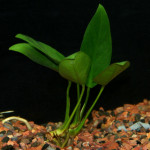 Anubias Congensis ( Anubias barteri ‘congensis’) Anubias Congensis is another form developed for aquariums from Anubias barteri plant. Congensis has dark green, waxy, spear-shaped leaves which grow to an average height of about 15 inches. Like most of the Anubias aquarium plants, this variation is adaptable to a wide range of aquarium conditions, and thrives in low to medium light levels.
Anubias Congensis ( Anubias barteri ‘congensis’) Anubias Congensis is another form developed for aquariums from Anubias barteri plant. Congensis has dark green, waxy, spear-shaped leaves which grow to an average height of about 15 inches. Like most of the Anubias aquarium plants, this variation is adaptable to a wide range of aquarium conditions, and thrives in low to medium light levels.
 Sagittaria (Sagittaria subulata) Subulata is a thin, grasslike plant. The leaves are green in coloration with some areas of reddish brown. A “dwarf” variant is often available as well as the “regular” Subulata but height is often dependent on lighting; the plants will grow taller in lower lighting but will stay more compact and spread laterally in higher lighting. Subulata will thrive in a wide range of water and light conditions, and may tolerate brackish water environments with very low salinity.
Sagittaria (Sagittaria subulata) Subulata is a thin, grasslike plant. The leaves are green in coloration with some areas of reddish brown. A “dwarf” variant is often available as well as the “regular” Subulata but height is often dependent on lighting; the plants will grow taller in lower lighting but will stay more compact and spread laterally in higher lighting. Subulata will thrive in a wide range of water and light conditions, and may tolerate brackish water environments with very low salinity.
If you have ever considered trying a freshwater planted tank, but did not know where to start, give some of these plants a try. Once you see how easy it can be, the sky is the limit, and you are on your way to becoming an aquatic gardener.
Until next blog,
Dave
 That Fish Blog – Aquarium Advice and Information
That Fish Blog – Aquarium Advice and Information

Thank you for creating such an awesome list of aquarium plants. All of these plants make a truly great addition to an aquarium. My favorite on the list would probably be the Java Fern because as you mentioned it can survive in many different conditions and is a really unique plant.
Thank you for sharing the entire list as this would help me build a perfect setup for my office. I got the setup from a website at http://www.aquaristiconline.com.au/collections/aqua-one , but had very less knowledge for which plants to put into the aquarium
Excellent list, I especially like that you took the time to seperate them into foreground, middle ground and background. You should mention that the crypts may melt in the aquarium when first added. But after growing a substantial root system they will regain health.
Hello Hayden, We have a whole separate blog dedicated to that topic! “Why Did My Plant Do That? – Part 2 – Melting Cryptocoryne” Glad you enjoyed this post!
Thank for sharing, I love marimo moss ball most.
Thank you for creating such an awesome list of foreground aquarium plants. I love to put more and more marimo moss ball in my tank as possible.
I’ve tried java fern several times, but it doesn’t last long in my aquarium. The pH is 7.6, NO2 0, NO3 5, KH 5, and I don’t know the GH. I don’t bury the rhizomes. I tried a couple of conservative doses of Leaf Zone, but it caused black patches on a couple of my anubias. The light is an Aqueon Full-Spectrum T8, and the bulb is under a year old. I keep it on for 6 hours a day, because any longer than that seems to cause algae. I really want to try java fern again, but don’t know why I can’t keep this plant that is reputed to be so easy. My anubias have been fine. What do you suggest?
Thanks!
Hello Lou, You mention Nitrite (NO2-) and Nitrate (NO3-); what is the Ammonia level? Also, what is the water temperature and Phosphate level? Six hours is a very short photo period for even low light plants and if you are seeing a lot of algae at 8-10 hours, I would expect that there may be a water chemistry issue somewhere feeding it that may also be affecting the Java Fern. What else is in the tank other than Anubias as well – fish, inverts, etc.? Finally, when you say it “doesn’t last long”, what does that mean? Is it simply decaying, breaking apart, turning black, turning transparent, not growing quickly?
Eileen, thanks for your reply. The Ammonia is currently at 0.1 ppm, and the Phosphate level is at 0.5 ppm. I have one betta. I give him one New Life Spectrum betta pellet twice a day.
The java fern would start developing brown-black patches a week or two after I put it in the aquarium. The patches would slowly spread, eventually killing the leaves.
This might be digressing from the original question, but the Ammonia might be a separate issue. It used to be at 0 ppm until a couple of days before my biweekly 25% water change, when it would start approaching 0.25 ppm. After the water change, it would be back at 0%. It was like clockwork. But a week ago, I found the Ammonia at 0.5 ppm and have been doing 30% water changes every couple of days. The Ammonia went from 0.5 to 0.25 with the first water change, but it has been decreasing much slower since then.
I wonder if the leftover bits of algae in the gravel might be causing this. I vacuum the gravel when I do water changes, but the gravel always has some algae stuck to it that gets left behind. Could it be decaying and causing the Ammonia and Phosphates?
I forgot to give the water temperature in my last post. 78-81.
Hello Lou, How large is this aquarium and do you have a filter on it? Low water flow can contribute to plant issues, and those water changes are actually fairly large and frequent and may be contributing to the problem. Changing too much water at a time or too frequently can remove too much of the beneficial bacteria that converts waste from Ammonia to Nitrite and then to Nitrate, essentially making it a new, uncycled aquarium. I would recommend testing your source water as well to see if it is adding Phosphates or any other compounds to the tank. For your temperature, 78-81 is pretty high. Are you using an internal or external thermometer for that and are you using a heater on the tank? I would recommend decreasing that to around a consistent 75-78 degrees. Also, check your GH level to make sure that that is appropriate as well.
Thanks again, Eileen. The aquarium is 5.5 gallons, and I have an adjustable hang-on-back filter set to the lowest flow setting for my long-finned betta. It’s a small filter made for nano aquariums. On a 10-point flow scale, anything past 2 gets disruptive for my betta. I could raise the flow rate and put a piece of filter sponge in the outlet to diffuse the flow from the filter.
I did the large, frequent water changes for only a few days to lower the ammonia. The ammonia reading is pretty low now (0.1). Should I go back to my usual 25% biweekly water changes and let the cycle handle the ammonia? I’d keep testing, of course.
I think I tested my tap water for phosphates and got 0, but I’ll test it again.
I’m using a 25W heater and an internal thermometer. I read somewhere that 74-80 degrees was the temperate range for a betta, so I set the heater to 77 to have a margin for error. I’ll lower it to 75.
I’ll tested the GH yesterday with an API strip, and it looks to me like 150.